Vision and Creativity
by Michael Frye | Nov 26, 2023 | Vision and Creativity
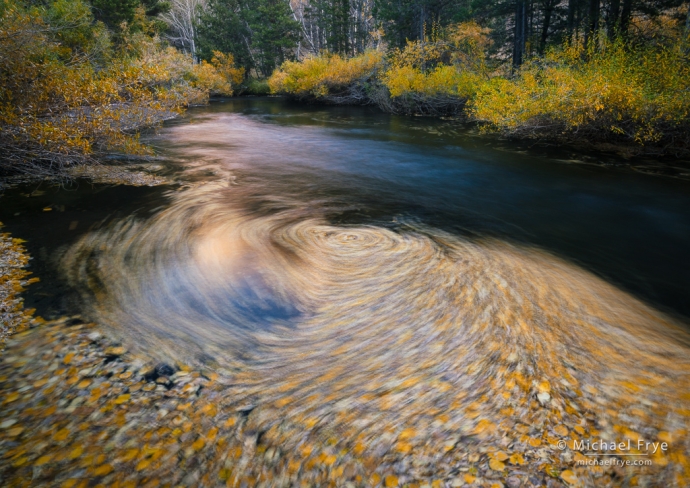
Swirling leaves, Inyo NF, California. (See the text for a detailed description of this photo.)
In between our visits to the Pacific Northwest Claudia and I spent a little time in the Eastern Sierra, and close to home in Yosemite. Last year I was in New Zealand in October, and I missed our local autumn, so it was nice to catch a bit of autumn glow in some of our favorite places.
When photographing familiar locations it’s easy to get jaded and think, “I’ve done all this before.” But actually you haven’t. No place is ever exactly the same, because things are always changing. And you’ve changed too; you’re not the same person, or the same photographer, as the last time you were there.
When I go back to a familiar spot, I often ask myself what’s changed – what’s different about the conditions that might create new opportunities. What’s happening now that’s interesting or unusual? It could be the light, the weather, fall color, flowers, water levels, beavers flooding a grove of aspens, a riverbank eroding… nothing ever stays the same.
(more…)
by Michael Frye | Nov 16, 2023 | Advanced Techniques, Vision and Creativity
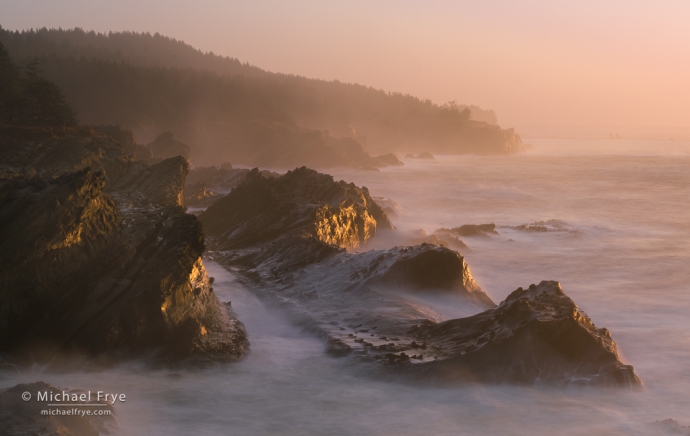
Misty sunset on the Oregon Coast. 73mm, 8 seconds at f/16, ISO 100, ND filter.
Claudia and I have been spending a lot of time in the Pacific Northwest this year, which is great, as I love this part of the world. We just finished a workshop along the Oregon Coast, and now we’re making our way to Bellingham, Washington, to visit our son and daughter-in-law, and stopping to see friends along the way.
The workshop was a lot of fun. A great group of people, and we saw some beautiful light, as well as big waves crashing against the shore.
(more…)
by Michael Frye | Jun 25, 2023 | Light and Weather, Vision and Creativity
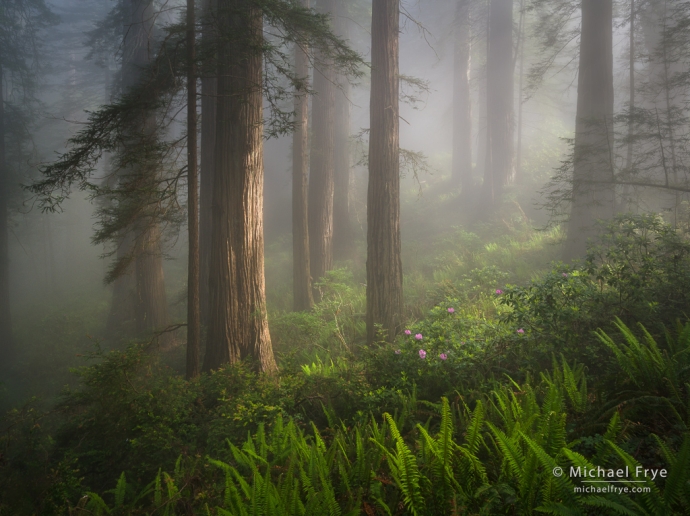
Redwoods, ferns, and rhododendrons, northern California coast. I’ve photographed sun breaking through fog in redwood forests many times, but it’s always a special treat. At this particular moment the sun highlighted the redwood trunk on the left, providing a visual focal point, with the ferns, rhododendrons, other trunks, and patches of sunlight all arranging themselves in a harmonious way. I consciously planted the tripod at a spot where I could see decent spacing and separation between the trunks.
Claudia and I have been traveling a lot this year, with trips to Mono Lake, Zion, Valley of Fire, Anza-Borrego and the Central Coast ranges for flowers, the Olympic Peninsula, and multiple visits to Death Valley – along with day trips to Yosemite, of course.
And recently we made another trip, this time to the northern California redwoods for our annual workshop there. But even though that was a long drive, it seemed like we were coming home, rather than leaving home. I always feel that way when we return to the redwoods, because I love that area so much.
(more…)
by Michael Frye | Dec 11, 2022 | Light and Weather, Vision and Creativity
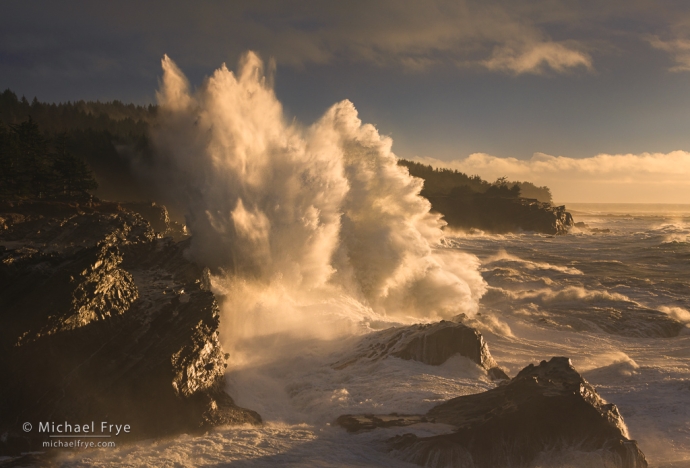
Crashing wave in late-afternoon light, Oregon coast. We had to deal with off-and-on rain while trying to photograph large waves crashing against the shore. But then the sun broke through for about five minutes late in the afternoon, bathing this scene in beautiful light. Luckily we caught a few big wave splashes during those five minutes. 70mm, 1/500 sec. at f/8, ISO 160.
After returning from New Zealand I made a trip to the Oregon Coast for our annual workshop. This part of the world is very different from my usual mountain haunts, which might be why I enjoy it so much. There’s a wild, rugged grandeur to this coastline, and if you’re lucky enough to encounter some big waves that just adds to the sense of awe.
And we did experience some big waves. Watching – and hearing – those monsters crash ashore was an experience none of us will soon forget. But even under calmer conditions this area offers wonderful opportunities to capture moody scenes of fog, or stormy skies.
(more…)
by Michael Frye | Nov 20, 2022 | Light and Weather, Vision and Creativity
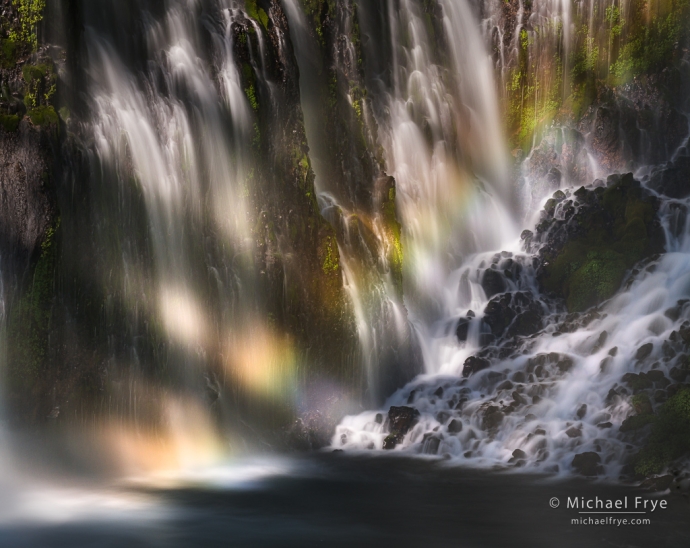
Tree shadows, rainbow, and waterfall, California. Claudia and I photographed this waterfall in soft light the evening before, but I came back the next morning hoping to see tree shadows when the sun got high enough. And sure enough, eventually trees cast beautiful striped shadows across the fall, creating a sunbeam-like effect. But I didn’t expect to also see a rainbow interspersed with the tree shadows – a nice bonus. I used a telephoto lens to fill the frame with the most eye-catching part of the scene, a polarizer to enhance the rainbow, and a neutral-density filter to slow down the shutter speed and give the water a soft, silky appearance. 135mm, 3 seconds at f/16, ISO 100, polarizer, ND filter (probably a 7-stop filter).
I love waterfalls. Who doesn’t? Besides their beauty, large waterfalls cast negative ions into the air, and negative ions supposedly have health benefits – making people feel refreshed and renewed, helping regulate sleep patterns and mood, reducing stress, and boosting the immune system. Or not; the scientific evidence is mixed at best. But whatever the reason, people seem magnetically drawn to waterfalls.
And of course waterfalls are quite photogenic. Over the past year I’ve had the opportunity to visit several waterfalls I’ve never photographed before. And while soft light usually works for waterfalls, I tried to seek out more unusual lighting conditions that could give the photographs a different look and feeling. That meant using sunlight, but waterfalls usually reside in basins and canyons, so they don’t often get that warm, low-angle light that we’re often looking for. And when the sun does get high enough to strike the fall, it’s often filtered through trees, creating splotchy light. Splotchy light can be harsh and downright awful, but sometimes, under the right circumstances, it can work. And – again, under the right circumstances – backlight can highlight a waterfall’s spray. And while front light is usually flat and boring, with waterfalls it can create rainbows.
(more…)
by Michael Frye | Sep 22, 2022 | Light and Weather, Vision and Creativity
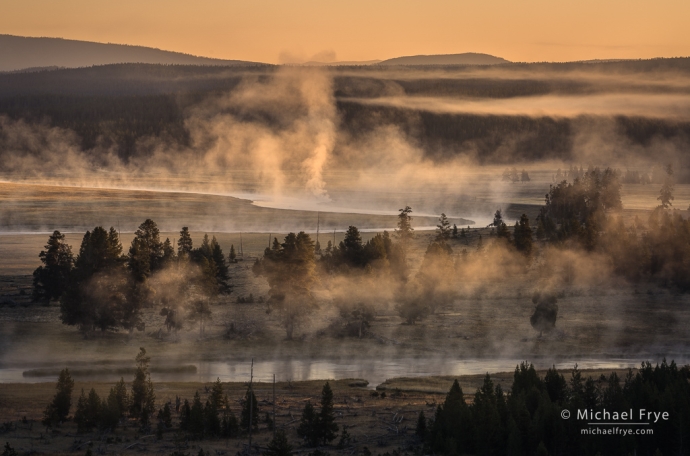
Layers of fog, Yellowstone NP, Wyoming. Early one morning I climbed a low hill, trying to gain some elevation so I could look down on the fog. After sunrise I noticed beautiful sidelight raking across this scene of a meandering river, so I raced along the hilltop to get a better view and composed this image. I like the horizontal layers of light and dark, punctuated by the vertical, curving column of steam that added a necessary visual focal point. 160mm, 1/20 sec. at f/16, ISO 100.
As I said in my last post, I love photographing fog and mist, so here are more misty images from our trip to Yellowstone. I explain my approach to photographing these scenes in that previous post, but the captions here contain more detail about the specific photos shown.
— Michael Frye
(more…)














